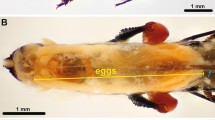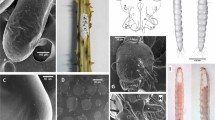Abstract
The functional morphology and the reproductive strategy of a parasitic isopod Onisocryptus ovalis in a bioluminescent ostracod Vargula hilgendorfii as its final host were studied based on video and SEM observations. During its lifetime, Onisocryptus ovalis dramatically metamorphoses several times, changing sex from male to female in the final host's carapace. At nearly the last ontogenetical stage, the parasite anchors its body with a pair of thoracopods to the posterodorsal region of the host ostracod's trunk and loses all the other appendages and thus its mobility as well. Thereafter, the parasite reverses bodily orientation during the final moulting so as to locate its mouth in the midst of the host eggs, and finally consumes them, leaving only the egg membrane. Such a mode of feeding of the parasite following the fixation of the body is interpreted in terms of the adaptation to escape elimination from the ostracod carapace by the host's cleaning appendages (the seventh limbs) and to obtain as much space as possible for the parasite's own eggs/embryos at the sacrifice of the mother's mobility. The synchronization between the timing of metamorphosis of the parasite and the reproductive cycle of the host animal can be expected to guarantee the parasite the opportunity to exploit sufficient nutrition from the eggs of the host.
Similar content being viewed by others
References
Abe, K., 1994. The light of Marine Fireflies. Chikuma-shobo, Tokyo: 214 pp (in Japanese).
Abe, K., T. Nagata & H. Hashizume, 1996. Digestive enzymes from the upper lip of a bioluminescent ostracod, Vargula hilgendorfii. Reports of the Faculty of Science. Shizuoka University 30: 35-40.
Abe, K., R. Reyment & F. Shinozaki, in press. Functional morphology and sexual dimorphism in the bioluminescent ostracod Vargula hilgendorfii and related species. In Savazzi, E. (ed.), Functional Morphology of the Invertebrate Skeleton. John Wiley & Sons, Ltd., London.
Abe, K. & J. Vannier, 1995. Functional morphology and significance of the circulatory system of Ostracoda, exemplified by Vargula hilgendorfii (Ostracoda, Myodocopida). Mar. Biol. 124: 51-58.
Abe, K., J. Vannier & Y. Tahara, 1995. Bioluminescence of Vargula hilgendorfii (Ostracoda, Myodocopida)-its ecological significance and effects of a heart. In Riha, J. (ed.), Ostracoda and Biostratigraphy. A. A. Balkema, Rotterdam: 11-18.
Cannon, H. G., 1940. Ostracoda. John Murray Expedition, Scientific Reports, 6: 319-325.
Nation, J. L., 1983. A new method using hexamethyldisilazane for preparation of soft insect tissues for scanning electron microscopy. Stain Technology 38: 347-351.
Reyment, R. A. & K. Abe, 1995. Morphometrics of Vargula hilgendorfii (Ostracoda:Crustacea). Mitt. Hamb. zool. Mus. Inst. 92: 325-336.
Sars, G. O., 1898. An account of the Crustacea of Norway with short descriptions and figures of all the species. Vol. II, Part XI-XIV: 193-270.
Shiino, S. M., 1942. Note on Cryptoniscus ovalis n. sp., a new cryptoniscan parasite (Epicaridea, Isopoda) found on Cypridina hilgendorfii. Ann. Zool. Jap. 21: 82-89.
Strömberg, J.-O., 1983. A redescription of Onisocryptus sagittus Schultz 1977 (Epidaridea, Cryptoniscina) with notes on hosts, distribution and family relationships. Polar Biology 2: 87-94.
Vannier, J. & K. Abe, 1992. Recent and early Palaeozoic myodocope ostracodes: functional morphology, phylogeny, distribution and lifestyles. Palaeontology, 35: 485-517.
Vannier, J. & K. Abe, 1993. Functional morphology and behavior of Vargula hilgendorfii (Ostracoda: Myodocopida) from Japan, and discussion of its crustacean ectoparasite: preliminary results from video recordings. J. crust. Biol. 13: 51-76.
Vannier, J. & K. Abe, 1995. Size, body plan and respiration in the Ostracoda. Palaeontology 38: 843-873.
Vannier, J., K. Abe & K. Ikuta, 1996. The gills of myodocopid ostracodes exemplified by Leuroleberis surugaensis (Cylindroleberididae) from Japan. J. crust. Biol. 16: 453-468.
Author information
Authors and Affiliations
Rights and permissions
About this article
Cite this article
Abe, K., Horiuchi, J. Reproductive strategy of an isopod Onisocryptus ovalis, parasitizing a bioluminescent myodocope ostracod Vargula hilgendorfii. Hydrobiologia 419, 191–196 (2000). https://doi.org/10.1023/A:1003912809679
Issue Date:
DOI: https://doi.org/10.1023/A:1003912809679




